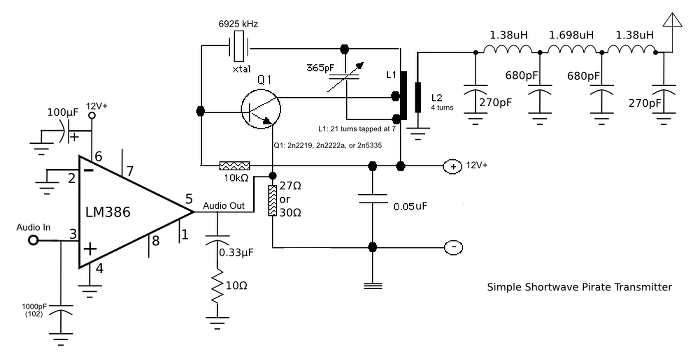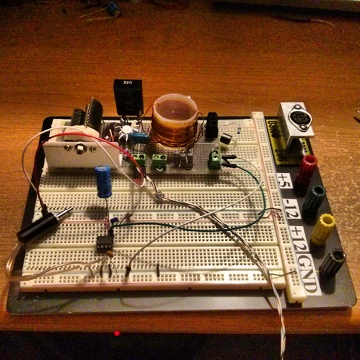The following schematic shows the three stages of our circuit. If you came across this article without reading my previous posts, and think this circuit looks difficult to build, it's not. Each stage is simple enough for novices to build, and the circuit is interesting enough for RF electronics experimenters to learn something. Hard to find parts can be found as usual by my recommendations here. Novices should try to build each stage of the circuit separately and ensure each works before putting it all together. The links provided for each stage cover in detail how each stage is built and how it works.
first stage is the audio modulator built from an LM386 IC with minimal parts. The modulated audio is fed into the second stage of the circuit which is the transmitter, configured for frequencies around 40 meters. The output of the second stage could be fed directly into an antenna or dummy load, but instead we will feed it into a third stage, a low pass filter, to filter out harmonics generated by the transmitter. The filter will ensure our signal only is present on the broadcast frequency, in this case 6925 kHz, a popular shortwave pirate frequency.

I recommend soldering this circuit up using perf board or using dead bug construction. Breadboard prototyping doesn't always work well for RF circuits, as they can add extra capacitance into the circuit. I was not able to get the low pass filter working properly until I soldered it up. The transmitter and audio modulator do seem to work on a breadboard, so your mileage may vary.
Here's a picture of the completed transmitter stage connected to the audio modulator on a breadboard. The transmitter is fed into a dummy load instead of the low pass filter, as I didn't want my signal to travel. The audio input is just a monaural headphones jack that can be plugged into a phone, mp3 player, or anything else with a headphones jack.

No comments:
Post a Comment